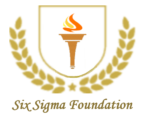Lean Six Sigma Green Belt - Body of Knowledge

SSF Lean Six Sigma Green Belt - BOK
The minimum recommended Body of Knowledge that any ATI needs to be compliant with for Accreditation with the SSF Lean Six Sigma Green Belt Level of Certification. Our unique approach to the BOK was designed as a necessary requirement to our equally unique approach of validating SSF ATI’s certification exams to democratize Accredited Lean Six Sigma Certifications by reducing costs incurred in training highly competent people resources by organizations. Refer BOK sections in brief or download composite pdf with all details below.

SSF Lean Six Sigma Green Belt Certification: Exam Focus Areas
Exam focus areas are those from where questions are deemed mandatory, so as to ascertain a student's comprehension for key (and minimal) expected knowledge areas along with demonstrable practical ability in order to attain a SSF Lean Six Sigma Green Belt Certification from a SSF Accredited Training Institute. This is a less exhaustive list than the Curriculum Focus Area list and is designed primarily to serve as a basic-guideline to validate the exam questionnaires as per SSF norms. On the whole though, the examination system and methodology for SSF ATIs is another area which gets validated separately for accreditation purposes by SSF, which Includes the online examination mechanism, proctoring controls, as well as the Bloom's Taxonomy (cognitive domain) Level expected to be evaluated in an objective manner in addition to the Exam Focus areas (and weightage of questions).
Focus Areas: Lean and Project Management
Mandatory Question Areas: Lean Methods 5S, A3, Concepts of continuous improvements (PDCA cycle and Kaizen), TPM basics
Overall Area weightage: 10%
Bloom’s Taxonomy (2001 revision) Level: Apply (Maximum Targeted Level for this Area)
Mandatory Question Areas: Project Management Basics, Project Selection Considerations and ROI
Overall Area weightage: 5%
Bloom’s Taxonomy (2001 revision) Level: Understand (Maximum Targeted Level for this Area)
Focus Areas: Six Sigma via DMAIC Lifecycle
Mandatory Question Areas: VOC, VOB, COQ, COPQ etc.; Developing CTQs, Project Charter Development
Overall Area weightage: 10%
Bloom’s Taxonomy (2001 revision) Level: Apply (Maximum Targeted Level for this Area)
Mandatory Question Areas: Data types, Six Sigma History, Six Sigma Levels and Baselining Process Performance, Measurement System Analysis, SIPOC
Overall Area weightage: 20%
Bloom’s Taxonomy (2001 revision) Level: Analyze (Maximum Targeted Level for this Area)
Mandatory Question Areas: Data vs Process Door Analysis, Sampling Techniques, Hypothesis Test Selection, Test Power, Significance and Error Types, Practical questions using some common tests.
Bloom’s Taxonomy (2001 revision) Level: Evaluate (Maximum Targeted Level for this Area)
Mandatory Question Areas: Regression analysis with Interpretation of Results (including Residuals plots), Difference between OFAT and DOE
Overall Area weightage: 5%
Bloom’s Taxonomy (2001 revision) Level: Understand (Maximum Targeted Level for this Area)
Mandatory Question Areas: Non-SPC: Poka-Yoke, SPC: Control chart selection
Overall Area weightage: 25%
Bloom’s Taxonomy (2001 revision) Level: Apply (Maximum Targeted Level for this Area)

SSF Lean Six Sigma Green Belt Certification: Curriculum Focus Areas
The List of recommended (essential) topics to be covered as part of an SSF ATI's Lean Six Sigma Green Belt certification training curriculum.
Focus Areas: Lean and Project Management
Lean
- Lean History and the TPS (Toyota’s role)
- Understanding Lean Fundamentals and Importance of Lean
- How Lean and Six Sigma Work together
- Lean Enterprise and Challenges
- 7 Wastes of Lean
- 3M in Lean
- 5S with Audits (explore Non-SPC control mechanisms)
- Ishikawa Diagrams
- Kaizen, PDCA cycle and concepts of continuous improvements
- Non-SPC Control Technique: Poka-Yoke
- TPM basics
Project Management
- Project Management Fundamentals
- Integrating DMAIC Lifecycle with Project Management
- Project Selection Considerations and ROI
Focus Areas: Six Sigma via DMAIC Lifecycle
Define
- Understanding Customer Requirements
- Basics like VOC, VOB, COQ, COPQ etc.
- Understanding the six-sigma breakthrough equation
- Developing CTQs
- Process Mapping Fundamentals
- Process Flowcharts Development
- SIPOC Analysis
- Project Charter Development
Measure
- Data types and Data Distributions
- Continuous vs Discrete Distributions with examples/use-cases
- Detailed focus on Normal Distribution (3-sigma rule, CLT etc.)
- Measurement System Analysis: Difference between Accuracy, Precision;
- Measurement System Analysis: Types of Errors viz: Bias, Linearity, Stability etc. with their impact
- Measurement System Analysis: Gage R&R, Attribute Agreement Analysis
- Data Collection Plan
- Six Sigma History
- Six Sigma Levels (Understanding DPMO, DPO, DPU etc.)
- Baselining Process Performance: Capability and Levels, Sigma Levels and Yield with related Metrics
Analyze
- Descriptive Statistics*
- Basic Graphical Analysis via simple graphs like Pareto Plots, Scatter Diagrams etc.*
- FMEA
- Hypothesis tests basics and general concepts (significance level, power, alpha, beta, p-value etc)
- Hypothesis tests error types
- Hypothesis tests selection process
- Hypothesis tests sampling
- Hypothesis testing on Normal data with common tests
- Hypothesis testing on Non-Normal data with common tests
- Contingency tables and using Chi-Square test
*These topics are being provided for reference and need of coverage, but may be covered in an earlier phase as well
Improve
- General Intro
- Common Ideation and Consensus building Techniques (Brainstorming, NGT etc.)
- Examining Correlation; Regression Analysis and Interpreting Results (including Residuals plot)
- OFAT vs DOE
- Piloting the Improvements
Control
- SPC vs Non-SPC Techniques
- Control Data Monitoring etc.
- Control Charts and their Fundamentals (Center Line, Control Limits)
- Common Variable Control Charts
- Common Attribute Control Charts
- Control Charts Selection based on Data types and Sub-group size etc.
- Examining Control Charts for Process Stability
- Control and Response Planning
- Project Handover and Project Closure Best Practices
Download the composite BOK for SSF Lean Six Sigma Green Belt as a pdf for reference.
